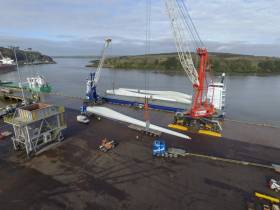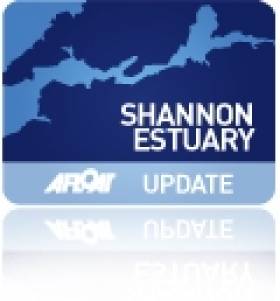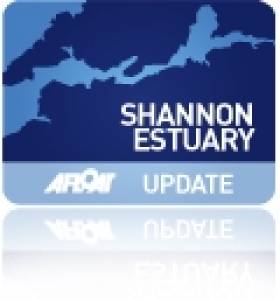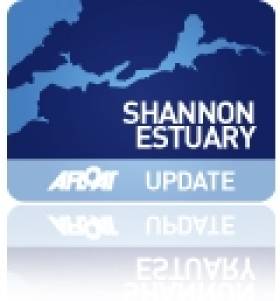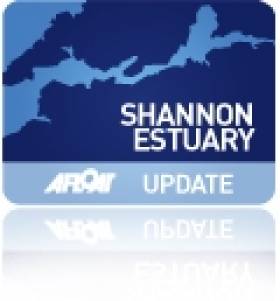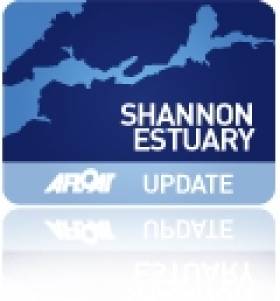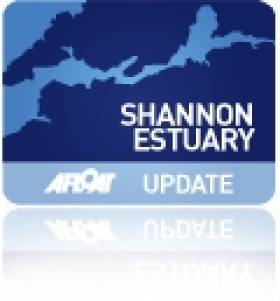Displaying items by tag: Port of Foynes
SFPC Press for Reopening of Foynes Port Rail Link
Since the announcement in October by Transport Minister, Shane Ross TD, of the €450m project to upgrade the N69 between Limerick and Foynes by 2026, pressure has been growing for funding to be provided for the currently mothballed rail line to Foynes Port to be re-opened.
The port on the Shannon Estuary, reports Fleet Transport, handles 10 million tonnes of cargo annually, is currently constricted by poor transport links to the rest of Ireland, but despite this 19% growth was achieved last year. The rail link would require less investment, estimated at €25m (2015 prices) – around 5% of the cost of the road. It potentially could be re-opened several years sooner if work were to commence promptly. A big advantage over the road scheme is that all land along the railway is already owned by CIE.
Shannon Foynes Port Company (SFPC) have been pressing for the re-opening of the line for many years now and were awarded EU funding to carry out a structural survey of it. Prior to this SFPC had arranged vegetation clearance in early 2015 to enable structural surveys to be carried out to the TEN-T link to the deep water port.
For further reading on calls to reopen the rail-link, click here.
#MidSizeShip - Astor which at 20,000 tonnes is termed as a mid-sized cruiseship called to Dublin Port today having made a cruise along the Wild Atlantic Way, writes Jehan Ashmore.
A pilot cutter in Dublin Bay came alongside Astor that had sailed overnight from Killybegs. The cruiseship made a leisurely late morning arrival in the port at around 11.30hrs. This compared to the routine majority of dawn arrival calls and mostly undertaken by considerably larger cruiseships.
The Astor was allocated a berth next to the Tom Clarke (East-Link) toll-bridge from where motorist commuters this evening will be able to glimpse the handsome looking vessel until departing at 19.30hrs. Cobh is the next port of call and so the Cork Harbour cruise berth will almost complete a full circumnavigation of the island since Astor called to Bantry on Tuesday.
The 600-only capacity cruiseship with its stylish funnel casing design is operated by German operator Transocean and UK based partner Cruise & Maritime Voyages. Early next month CMV's soon to be replaced flagship Magellen is to make a call to Dublin from Newport. The south Wales port is not normally associated with the cruise sector however Magellan is to make an overnight call.
As for Astor, here's a brief description of facilities. Asides the expected wide range of dinging options, there is a library, card room, internet café and a shopping arcade featuring a boutique, jeweller and perfumery. There is the Wellness Centre offering hairdressing and beauty treatments, an indoor swimming pool, ocean view gym, sauna and massage facilities.
Apart from Bantry Bay from where another smaller ship Serenissima recently opened the season at west Cork location, Astor also headed into the Shannon Estuary to Foynes. Notably the mid-west port is infrequently used by the cruise sector despite its accessible deep waterway.
A sister of Astor, Saga Pearl II but operating for Saga Cruises has also offered cruisegoers to experience less well known ports and or are less accessible to larger deep drafted ships. In the case of Saga Pearl II a call was made to Warrenpoint and given its location requires a passage up Carlingford Lough presenting a mountainous coastal backdrop. The call to the Co. Down port was the first ever by a cruiseship and this took place in 2014.
Also further along the Down coast is another beauty spot, Strangford Lough, where the aforementioned Serenissima called to Portaferry yesterday. This call by Serenissima Cruises follows their opening of the cruise season in Dun Laoghaire Harbour on Wednesday.
Fred Olsen have also offered cruisegoers in recent years to visit less well explored ports in Irish and UK waters among them Barrow-in-Furness in Cumbria. More of their mid-sized cruiseships will be seen throughout Irish waters as the season begins to get busier this month.
New Maritime Museum in Foynes Officially Opened by Tourism Minister
#NEWmaritimeMuseum – Foynes Flying Boat & Maritime Museum welcomed Michael Ring TD, Minister of Tourism & Sport who officially opened yesterday the mid-west tourist attraction's new maritime museum.
Minister Ring said "This new Maritime Museum adds greatly to the overall Foynes Flying Boat Museum, and will attract repeat visitors as well as many maritime enthusiasts, keeping Foynes at the forefront of tourism in the Shannon Region and on the new Wild Atlantic Way.
"I am pleased that the Government, through Fáilte Ireland, has provided support to this very worthwhile project under the Tourism Capital Investment Programme.
"I know that the development of a Maritime Museum, that would tell the story of the River Shannon and the influence on the lives of those communities living nearby, has always been a goal of the Museum's management here at Foynes. This ambition has now been realised".
The new maritime section tells the story of one of Ireland's great maritime assets... the River Shannon. The exhibits on display detail the geology, personality and mythology of the estuary stretching from Limerick docks down to Loop Head, marking the mouth of the Shannon at its seaward limits.
As previously reported the diversity of topics on display in the new maritime museum is a combination of interactive technology, artefacts, replica exhibits, and a stunning view of Foynes from the recently reinstated control tower that was used for the trans-Atlantic flying boats.
The tower has a balcony (equipped with bino-cularscopes) where shipping activity can be directly observed from and inside the tower and from where there is a photo-montage outlining the various landmarks of the village and estuary.
The view overlooking Foynes includes Foynes Yacht Club, Foynes Island and in the far distance across the estuary is the Aughinish Alumina processing plant.
During yesterday's opening ceremony, the dry-bulker Foxtrot could be seen at a Port of Foynes berth directly opposite from the observation tower and where cargo was been loaded on board.
Shannon Foynes Port Company (SFPC) earlier this year launched the master plan vision to 2041, which looks forward to the future and the museum is doing its part to preserve the past for the future.
The new addition to the award-winning Flying Boat Museum completes the overall plan that was first envisaged back in 1987 when a small group of interested people got together to look at the possibility of establishing a Flying Boat Museum in the Co. Limerick village.
Failte Ireland partly funded the new museum under their National Development Plan 2007 – 2013 programme which in this phase totalled €1.5m in which 75% was funded from Failte Ireland. The remaining funding where met through the museum's own resources and with financial assistance from Limerick County & City Council.
This now brings the total investment in Foynes Museum to €4.5m over the past twenty five years. The centre supports 16 employees and this season has attracted 40,000 visitors. For the second time the museum has been given a Silver Award for best visitor attraction by CIE Tours in 2012.
This year the museum achieved a Certificate of Excellence from Tripadvisor and has featured in many TV holiday shows and documentaries both at home and overseas.
In 2014 the museum is to feature in BBC Getaways, the TV3 Documentary "The Island" and a documentary on Ireland's role in aviation to be screened on RTE and to go on general release.
SFPC Welcomes 'Game-Changing' New Foynes Port-Limerick Road Scheme
#FoynesPort – Shannon Foynes Port Company CEO Pat Keating has described the procurement of engineering consultancy services for the Foynes to Limerick Road Improvement Scheme as a hugely significant moment in realising the enormous investment and employment potential of the estuary.
The scheme will provide a high quality road to connect the Port of Foynes with the M7/N18 at Limerick. The N69 National Secondary Road currently connects Foynes to Limerick along 32km of single carriageway.
Welcoming the announcement by Limerick City and County Council, Mr Keating said that the development of the high-quality road between Foynes and Limerick would be a 'game-changing' moment for the port company.
"This commitment is one of the most important developments in the history of Shannon Foynes Port Company. Its benefits will be felt not just by the Port Company but by the wider region as this road is a central piece to facilitate our plans for very significant economic growth along the Shannon Estuary.
"We are planning to double tonnage at our ports and anticipate significant job creation on the estuary over the next 30 years. We have signaled that two key pieces of infrastructure are critical for this to happen.
One is the regeneration of the rail link to Foynes, which we are actively seeking to advance, and the other is the development of a quality road link to Limerick.
"The road link is an absolutely essential piece for us. We have a huge opportunity to attract investment and industry over the coming decades thanks to the advantage that the estuary's unique deep-water gives us. But we will not be able to deliver on these plans unless there is a quality transport network.
"Heavy goods traffic alone could increase by as much as 350% over the life time of our Vision 2041 Masterplan. The N69 is inadequate as things stand, let alone with a tripling of heavy goods traffic. The development of this high quality road to connect Foynes with Limerick is, therefore, essential. Otherwise growth will be seriously constrained and opportunities will be lost."
Mr Keating said that the announcement is a definite show of commitment to the project by the Department of Transport, the NRA, the Mid West National Roads Design Office and the local authority.
"We cited the importance of this road link when we launched Vision 2041 and to have such a prompt commitment is very encouraging. We look forward now to the selection of a preferred route in 2014, followed by the public consultation process and then on to the actual delivery of the new road."
Shannon Cruiseship Season to Start with a Voyager
#CruiseLiners – The Shannon Estuary's main port of Foynes, the gateway to mid-western visitor attractions, is to welcome three cruise callers this season, starting next week with a call by Voyages of Discovery's 15,396 tonnes Voyager, writes Jehan Ashmore.
Holland America Line's 37,845 tonnes Prinsendam is due on 13 August and the final caller will be Pheonix Reisen's 28,856 tonnes Amadea which is scheduled to visit a month later on 13 September.
Last week SilverSeas six-star rated Silver Whisper which is today calling to Invergordon, Scotland, was to open the cruiseship season on the Shannon, however this was cancelled to weather related conditions.
She along with her expedition fleetmate Silver Explorer made a recent call together in Dublin Port. Silver Whisper moored alongside a berth close to the East-Link bridge.
This particular berth is currently re-occupied by the 19,000 tonnes Belize flagged bulk-carrier Clipper Faith which is advertised for public auction under the instructions of the Admiralty Marshall of the High Court.
Foynes Irish Coffee Festival
#FUN ON THE SHANNON – Today is the last day of the Foynes Irish Coffee Festival, where there is still plenty to do and see during this afternoon's line-up of the festival programme.
In port the public will be able to visit the Naval Service coastal patrol vessel L.E. Orla (P41) between 2–5pm.
Keeping to matters nautical, the Munster Mermaid Championships is been held in the Foynes Yacht Club which is celebrating its 50th anniversary this year. To mark the occasion there will be a series of competitions and a fun day held on the water.
There is a Food and Irish Craft Fair, Pet Farm, a Ceile Mor, historical walks of the town and a McFaddens Carnival, for further details of times and locations see the events guide.
During the mid-afternoon there will be Irish Coffee making demonstrations in the Foynes Flying Boat Museum, where current Irish Coffee Making Champion Roisin Sweeney will be there.
In the evening the festival culminates when finalists will be competing for the Powers Irish Coffee Making Champion 2012. The event will also be held in the museum which features a replica of a flying boat that once served the mid-west hub airport.
Silverseas Sails to Shannon Estuary
#SHANNON SILVERSEAS - The mid-west port of Foynes is playing host to the ultra-luxurious Silver Whisper (2001/28,000grt) which docked along the Shannon Estuary this morning, writes Jehan Ashmore.
The vessel operated by Silverseas Cruises had sailed from Southampton and at least another call by another vessel is also scheduled this season. On average the Shannon Foynes Port Company handles four cruise calls each season.
One of the main visitor attractions along the Shannon is the local Foynes Flying Boat Museum, which retraces an altogether different era in transportation, yet also carried out travel in style when the B314 flying boats used the Co. Limerick terminal between1937-1945. Then the trans-Atlantic travellers spent time at the Foynes hub-terminal which also became home to the 'Irish Coffee'.
On board the 382 passenger capacity vessel she has a near equal number of crew at 302. This passenger to crew ratio is exceptionally high and reflects her status in the very top end of the cruise travel market. Silverseas have over the years won a whole string of globally recognised travel industry awards.
All accommodation on board the 186m / 610ft long vessel is based in suites cabins (available in seven grades) with each featuring a balcony of ocean views and countless destinations.
Facilities include boutique shopping; a wellness spa with beauty salon, fitness centre and sauna; full-scale productions in a multi-tiered show lounge; a casino, an internet café and Wi-Fi service. To read the full range of facilities and virtual tours click HERE.
In 2012 the Silver Whisper cruising schedules are to Brazil then to South Africa and the Indian Ocean landscapes. Beyond that she heads for the South China Sea, west to the Arabian Sea and Egypt.
During the summer she explores Europe before arriving in Canada for autumn's vibrant 'fall'. Silver Whisper's globetrotting culminates in the Caribbean with cruises through the year's end.
Foynes Hosts Emergency Ship Fire Drills
#SHANNON ESTUARY – The Maritime Journal reports that a simulated fire and rescue drill simulating a fire on board a ship took place in Foynes Port this week.
Limerick County Fire & Rescue Service with the assistance of Shannon Foynes Port Company and Celtic Tugs which operates a fleet of tugs in the port hosted the Ship and Ports Course.
A number of exercises were carried out during the course, to read more on the exercise click HERE.
Masterplan for Shannon Foynes Port Company
Port expansion options are to be examined so to prepare ports for larger trade volumes when the opportunities arise. Also under consideration are the non-core assets at the Port of Foynes and Limerick Docks. To read more about the masterplan and the challenges and issues that has been identified in both ports click HERE.
The statutory jurisdiction of the estuary is under the control of SFPC, which is responsible for the estuary that runs from the mouth entrance marked by Kerry and Loop Heads and stretching far inland to Limerick City. The natural waterway can handle vessels of up to 200,000 deadweight tonnes (dwt) which are the largest ships that can dock in Irish waters.
Cargo Ships Collide in Shannon Estuary
The second vessel, the 93-metre Danish-registered Tina Theresa, was leaving the anchorage to meet up with the Shannon estuary pilot when the collision took place. The tanker was destined for Foynes Port in Limerick and was damaged along her starboard side but there was no hull damage.


























